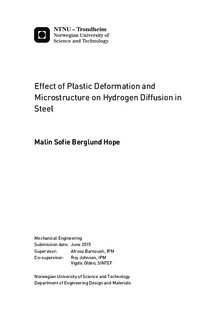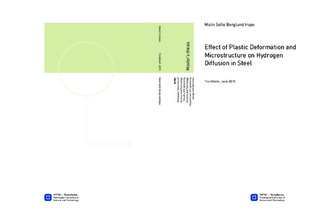| dc.description.abstract | This work has been part of the ROP (Repair Contingency of Pipelines) project executed by SINTEF, where Vigdis Olden is project lead. The main content of this report is the execution of hydrogen permeation tests on Fe3wt.%Si and API X70 high strength steel.
The permeation tests were performed according to the ASTM Standard Practice for Evaluation of Hydrogen Uptake, Permeation, and Transport in Metals by an Electrochemical Technique [1], and the apparatus used for testing was designed and produced during a previous project work [2]. The tests were performed at temperatures of 30°C, 50°C and 75°C, and compared to previous results. The Fe3wt.%Si samples were tested as received, while the X70 steel samples were tested in the form of as received base metal (BM1), pre-strained base metal (BM2) and heat affected zone (HAZ1). BM1 and HAZ1 had 0% pre-strain, while BM2 had 1% pre-strain. The HAZ samples underwent heat treatment to obtain a coarse grain structure, which occur in the zone close to welds. All the samples were tested without palladium (Pd) coating on the anodic/exit side. The main analyzing methods utilized were the tlag method as recommended by the ASTM standard [1], and also a more complex diffusion model including trapping parameters developed by Iino [3-5] by using a curve fitting software developed by Simonsen [6]. The latter one is referred to as the trapping model.
The trapping model gave higher values for the effective hydrogen diffusion coefficient, Deff, than the tlag method. According to the trapping model, the Deff for Fe3wt.%Si varied from 1,69·10-10 to 1,75·10-9 m2 s-1. For the X70 steel samples, the obtained Deff values were higher. For X70 BM1, the Deff according to the trapping model varied from 8,47·10-10 to 4,77·10-9 m2 s-1. For X70 HAZ1, Deff varied from from 5,00·10-10 to 3,39·10-9 m2 s-1, while for X70 BM2 it varied from 8,21·10-10 to 1,59·10-9 m2 s-1. Fe3wt.%Si, X70 BM1 and X70 HAZ1 were tested at a temperature range of 30°C-75°C, while X70 BM2 was tested only at 30°C.
Fe3wt.%Si showed a lower Deff than all the X70 steel samples. According to microstructural investigations, this was an unexpected event. However, the theory that grain boundaries may act as fast paths for hydrogen diffusion presented in the literature may have been an explanation due to the smaller grains and many grain boundaries in the X70 steel compared to Fe3wt.%Si. X70 BM2 showed a higher diffusion coefficient than X70 BM1 at 30°C, meaning the Deff increased with increased pre-strain level in this thesis. This was not in accordance with previous results and literature. X70 HAZ1 showed a lower Deff than X70 BM1, which was in accordance with previous results.
The sub-surface concentration C0 was quite constant for the different materials, except for X70 HAZ1. For Fe3wt.%Si, X70 BM1 and X70 BM2, it varied from 1,89·10-3 to 2,03·10-2 ppm W based on the Deff values from the trapping model. For X70 HAZ1, it varied from 9,12·10-3 to 2,45·10-2 ppm W. This suggested that C0 was unaffected by pre-strain level, but affected by the heat affected zone (HAZ) for X70 steel.
Fe3wt.%Si showed a higher density of reversible traps, Nr, and a lower reversible trap binding energy, Eb, than X70 steel in general. X70 BM1 showed a slightly higher Nr than HAZ1, which was not in accordance with previous results. Eb was slightly higher for X70 HAZ1 compared to BM1, which, on the contrary, was in accordance with previous results. Eb and Nr for Fe3wt.%Si were 17,56 kJ mol-1 and 2,12·1022 sites cm-3, respectively. For X70 BM1, Eb and Nr had values of 26,56 kJ mol-1 and 1,29·1020 sites cm-3, and for HAZ1 the obtained values were 28,12 kJ mol-1 and 1,15·1020 sites cm-3. X70 BM2 was only tested at 30°C because of limited amount of time, meaning Eb and Nr could not be obtained.
When comparing to previous results, a lower steady state permeation current Iss measured on the anodic side and charging transients less steep than Fick s curve was noticed for all or many of the tests executed in this thesis. These events were an indication of a surface controlled diffusion situation, which was suspected to have been the case in this thesis. Surface examinations of both the anodic/exit and cathodic/charging side of the samples after testing revealed a slight oxide layer formation, carbon contamination, pitting on the anodic side and also etching of the surface on the cathodic side. | |

